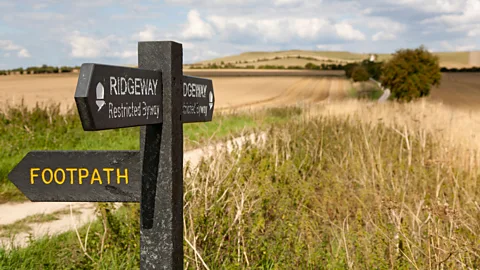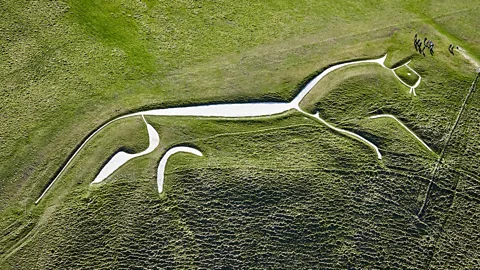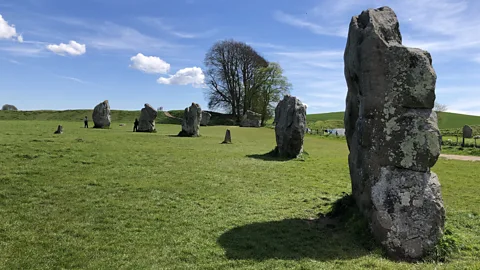The Ridgeway: Hike the 5,000-year-old pathway that's Britain's oldest road
 Alamy
AlamyWalk in the footsteps of Celtic druids, Saxon kings and Victorian poets on an 87-mile prehistoric trackway that cuts across the chalk hills of southern England.
It was 10:00 before I saw another person, a lone dog walker in the vicinity of Barbury Castle, an Iron Age hill fort that sits commandingly atop a rise on the Ridgeway, an 87-mile prehistoric trackway widely recognised as Britain's oldest road.
I'd set off more than two hours earlier from Avebury in Wiltshire, revelling in my newfound solitude while, at the same time, finding it increasingly difficult to believe that I was walking through such a densely populated region. From the backseat of a car, England's southern counties resemble an untidy muddle of motorways, high streets and housing estates. But up on the chalky heights of the North Wessex Downs, I was being treated to an infinitely more tranquil view.
As I progressed north-east along the rounded ridgetops, I gazed out over distant villages, bushy hedgerows and rolling green pastures interspersed with yellow rapeseed fields. A red kite soared overhead, and a cool breeze ventilated the earthen ramparts of 2,500-year-old Barbury Castle. It felt as if I'd serendipitously walked into the eye of a hurricane and found calm amid the chaos. The silence was therapeutic.
The Ridgeway is an ancient path that cuts diagonally across the chalk downs of southern England linking Overton Hill, a site of special archaeological interest in Wiltshire, with the prominent 233m summit of Ivinghoe Beacon in Buckinghamshire, a mere 33 miles from London.
 Alamy
AlamyPart of a much longer trading route that once connected the coasts of Dorset and Norfolk, the trackway follows a chalk escarpment that acts as a natural dividing line between low-lying vales and river headwaters. Used as a protective bastion and lookout during the Iron Age, it later became a military road for Saxon armies and a farm track for medieval drovers and herders. In 1973, the path was designated a National Trail and recently celebrated its 50th anniversary with a special walk and a year-long treasure hunt that highlighted the Ridgeway's top-50 features, from its inspiration to writers such as JRR Tolkien and Thomas Hardy to its appearance in the 2019 Star Wars film The Rise of Skywalker.
Proof of its antiquity is everywhere. The Ridgeway is littered with Neolithic burial mounds, Iron Age hill forts and, most famously, a giant 3,000-year-old chalk etching known as the Uffington White Horse that is emblazoned across a grassy escarpment in Oxfordshire like a primitive Picasso. Historical evidence suggests it has been in regular use for at least 5,000 years, conceivably making it the oldest continuously utilised path in Europe. With few 21st-Century interferences to distract me, I clicked my phone into silent mode and pictured myself walking in the footsteps of Celtic druids, Saxon kings and Victorian poets.
A short walk from the starting point at Overton Hill, I began my quest with a stroll up to one of Britain's oldest gravesites, the West Kennet Long Barrow, a chambered burial mound built around 3650 BCE by some of Britain's earliest farmers. Nearby in Avebury, where I spent my first night in a comfortable B&B and dined in a supposedly haunted pub, I wandered around a Bronze Age stone circle contemporaneous with Stonehenge and a giant manmade mound called Silbury Hill that's as large as Giza's pyramids and nearly as old.
For walkers, the Ridgeway is a journey of two distinct halves divided by the River Thames at a natural gap in the hills called the Goring Gap. To the west rise the North Wessex Downs, an elongated chalk ridge topped by four pre-Roman hillforts – Barbury Castle, Liddington Castle, Uffington Castle and Segsbury Camp – and two notable geoglyphs, the Uffington White Horse and Hackpen White Horse. To the east lie the more wooded Chilterns where tracts of ancient beech forest are embellished by bluebells in spring and dotted with houses built with local flint stone.
 Brendan Sainsbury
Brendan SainsburyBoth regions have been designated "Areas of Outstanding Natural Beauty" and harbour a gentle, timeless quality. In the North Wessex Downs, I walked for miles through countryside that's changed little since the intensification of farming in the 1700s. Lack of water sources on the uplands meant that settlements were invariably sited in the valleys, leaving the ridgetops to nature. During my first morning on the path, I crossed only one significant road and didn't encounter a sizeable village until Streatley, at the 40-mile mark.
While the scenery isn't as spectacular as the Alps or the Rockies, there's something quintessentially English about the grassy coombes (dry valleys) and rustling beech copses that punctuate the route. Walkers and ramblers regard them with deep reverence.
"The Ridgeway forms an interface between the lowland and the chalk downs," explained Dave Cavanagh, a trustee of the Friends of the Ridgeway who lives close to the trail in the village of Uffington and has walked sections of the route many times. "From the Ridgeway you can look north for many miles over the Vale of White Horse to the Cotswolds and Chilterns, or west over the Vale of Aylesbury and beyond. Then you turn 180 degrees for a totally different view, over the downs. Lots of habitations in one direction, hardly any in the other. It's a different world up there, with a great getting-away-from-it feeling."
As I tenaciously ground out the miles, his words rang true. With the weather cooperating for the first couple of days, I gradually became immersed in my ancient surroundings. Horses are a recurring theme on the downs. Most of the Ridgeway is a designated public bridleway dotted with sloping pastures and "gallops" where talented jockeys train for races. More than once, I heard the thunder of approaching hooves and momentarily imagined a posse of Saxon warriors appearing on the horizon.
 Brendan Sainsbury
Brendan SainsburyAs I progressed into the Chilterns, the trail became less remote, crossing roads and meandering through occasional villages. Modern obstacles sometimes interrupted the path. In contrast to the prehistoric animal herders of yore, I was obliged to navigate my way across the fairway of a busy golf course, and traverse the private driveway of Chequers, the country residence of the British prime minister.
More like this:
• An epic 38-mile hike to England's northernmost point
• A new chance to hike Europe's ancient salt route
• A three-day canoe trip into Scotland's sublime borderlands
I spent my nights in a mixture of B&Bs, hostels and pubs. Often depicted as disappearing vestiges of British life, rural pubs remain an integral part of Ridgeway folklore. Offering comfortable rooms and full English breakfasts served with an idiosyncratic dose of local history, they were one of the highlights of the route. Some establishments require a diversionary walk to a nearby village, others – such as the Bull Inn at Streatley and the Shoulder of Mutton in Wendover – sit directly on the trail.
While human traffic on the Ridgeway appeared relatively light – except in tourist hotspots such as Waylard's Smithy (an atmospheric Neolithic long barrow in a beech copse) and the Uffington White Horse – usage has noticeably increased in recent years, especially since the pandemic.
"The Ridgeway is within easy reach of many thousands of people, including the conurbations of Swindon, Luton and London," Cavanagh said. "Once there, the walking can be easy, much of the Ridgeway being more or less level, with a good chalk surface."
He testified to a 10-fold increase in followers on the Friends of the Ridgeway Facebook page during the 50th anniversary year, a trend confirmed by Mary Tebje, the comms support for the Ridgeway National Trail.
"Whilst it is an ancient trail, its 50th year as a designated National Trail gave us an excellent reason to remind people why these countryside spaces are so important," she told me. "These include: a place to exercise, spend time with family and friends, to learn about and subsequently care for our countryside, its biodiversity, history, heritage and even climate change as the new weather patterns impact when and how we can access the trail."
 Brendan Sainsbury
Brendan SainsburyThe weather became a problem for me on the final day when heavy rain turned the path in the Chilterns into a quagmire of thick, slippery mud. Undeterred, I soldiered on, aware that I was on hallowed ground and never 100% sure about what was lurking beneath my feet. As utilised as the Ridgeway is, it remains riddled with copious unsolved mysteries. In April 2019, waterpipe workers digging near the trail at Letcombe Bassett, accidently unearthed the 3,000-year-old remains of 26 skeletons that may have been part of a human sacrifice. It was a sobering thought.
On concluding my walk and staggering exhausted into a provincial station for the comparatively short train ride into London, I was left with the intriguing notion that, despite its antiquity, the Ridgeway continues to throw up new secrets.
Slowcomotion is a BBC Travel series that celebrates slow, self-propelled travel and invites readers to get outside and reconnect with the world in a safe and sustainable way.
--
If you liked this story, sign up for The Essential List newsletter – a handpicked selection of features, videos and can't-miss news, delivered to your inbox twice a week.
